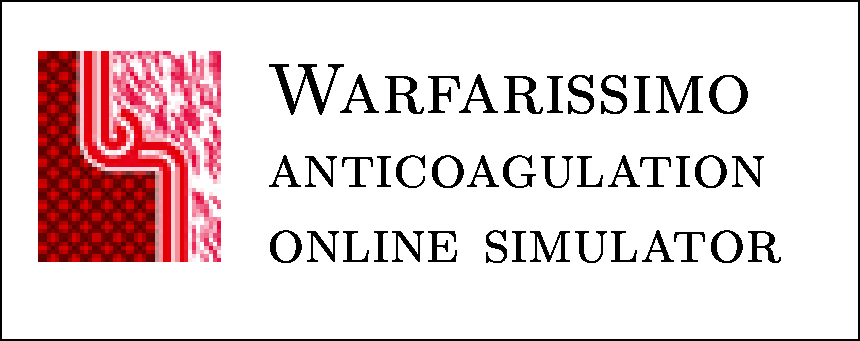
How does it work.
Warfarissimo works by implementing a detailed mathematical representation of a clinical model of the absorption, distribution, elimination and action of anticoagulants, which attempts to integrate some of the experimental results available in the literature.
The Warfarissimo pharmacokinetic model uses two compartments: one representing the digestive tract and one representing the rest of the body. The digestive tract is used only for absorbtion. The racemic mixture of the (S)- and (R)- forms of the coumarinic derivative is made to diffuse instantly in the first compartment and then to pass completely in the body compartment with a half-life of 30' until all is absorbed.
Both the (S)- and the (R)- forms are entirely eliminated through hydroxylation by four enzimes: CYP2C9, CYP2C19, CYP2A1 and CYP3A4. Their relative contribution for each substrate was taken from [Lee & al., 2002], [Tassies & al., 2002] and [Thijssen & al., 2000].
The user can only adjust the activity of CYP2C9, the genotypes of which are well known. We could not find literature on the in vivo activity of the enzyme. However, the average warfarin maintenance doses are reported in [Aithal et al., 1999], [Taube et al., 2000] and [Margaglione et al., 2000] and the acenocoumarol maintenance dose in [Tassies et al., 2002].
We searched through simulation the in vivo values of CYP2C9 activity which would correspond to the maintenance doses from the literature. Taking a conventional activity of 1.0 for genotype *1*1, we found that, on average, an activity of 0.7 would correspond to genotype *1*2 and one of 0.4 to genotype *1*3. There may be some interindividual variability of the CYP2C9 activity among subjects with the same genotype.
A constant pool of proteic precursors of coagulation factors is presumed to exist, in our model. Gamma-carboxylation of the precursors to active factors is supposed to take place simultaneously with the reduction of Vit-K1H2 to Vit-K1-2,3-O. The rate of this process corresponds for each protein to its half-life, taken from [Hardmann & Limbird, 2002].
Vit-K1-2,3-O is reduced back to Vit-K1H2 by an enzymatic system which is not dependent on warfarin and by a stronger Vit-K epoxyde reductase (VKOR) which is dependent on warfarin [Cain & al., 1997]. VKOR is bound irreversibly to Warfarin [Fasco & al., 1982].
The reaction constants for the above reactions were adjusted such that the evolution of the levels of circulating coagulation factors for a 70kg man with the *1*1 genotype followed the average reported in [D'Angelo & al., 2002] under the same treatment regimen. The relationship between the circulating factor levels and the INR was also adjusted to reproduce the results from [D'Angelo & al., 2002].
These mechanisms were implemented in the form of a system of ordinary differential equations.
*We will only use your e-mail address to answer your message.
(c) 2002-2008 A.D. Corlan







